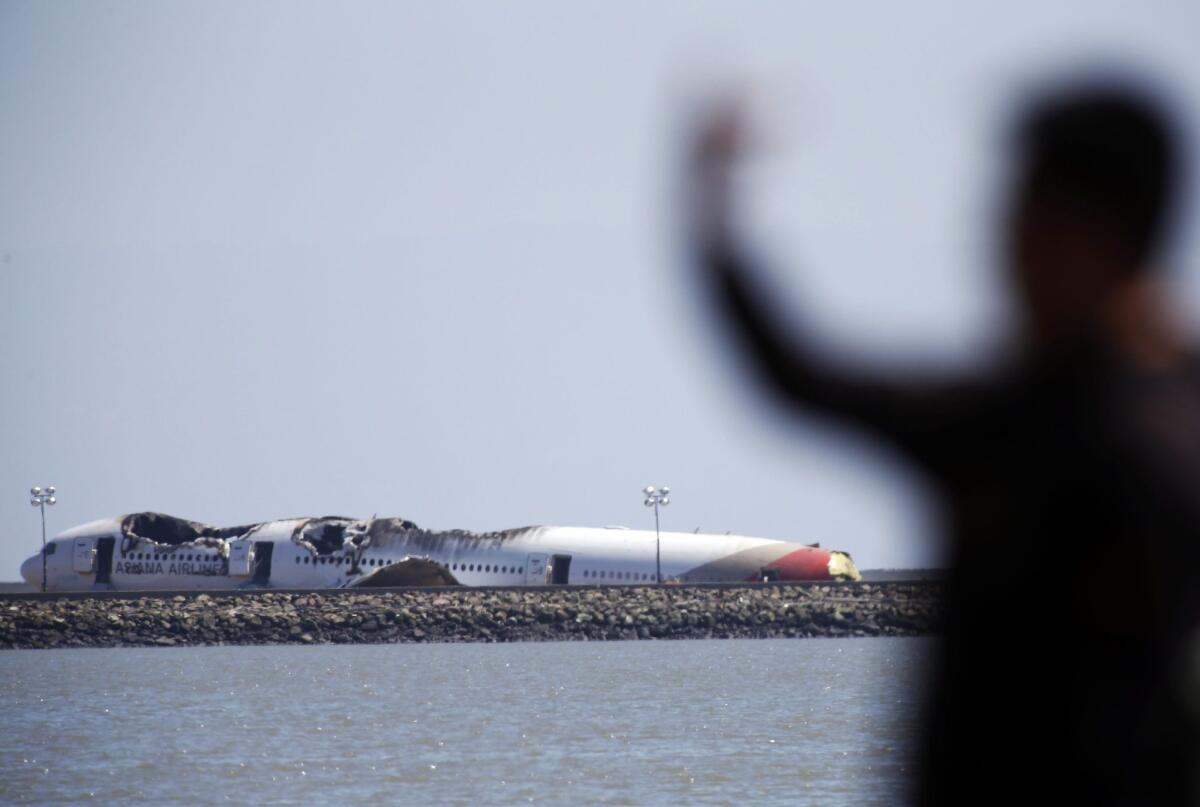Asiana crew member sought 2nd pass at landing moments before crash

- Share via
An Asiana Airlines crew member requested to abort his plane’s landing and go around for another pass less than two seconds before it crashed at San Francisco International Airport, according to federal investigators.
Asked at a Sunday news conference about the role of pilot error in the crash, Deborah Hersman, chairwoman of the National Transportation Safety Board, stressed that the investigation into Saturday’s tragedy, in which two were killed and scores were injured, would probably take more than a year and that “everything is on the table right now. It is too early to rule anything out.”
The pilot of Asiana Flight 214 had only 43 hours of experience flying the Boeing 777 aircraft, a spokeswoman for South Korea-based Asiana said Sunday. Lee Kang-kook, born in 1967, was in training on the 777 when the crash occurred, she added.
DISCUSSION: Latest developments on Asiana jet crashThe spokeswoman, Lee Hyo-min, told The Times the pilot had been flying since 1994 and was a “very experienced pilot” in other types of planes, including Boeing 747s, 737s and Airbus 320s.
Hersman said Flight 214 made no distress calls and appeared to be operating smoothly moments before it slowed to a near-stall, crashed into a sea wall near the runway and broke apart.
“There is no discussion of any aircraft anomalies or concern with the approach,” Hersman said.
Seven seconds prior to impact, a call is heard on the flight recorder from one crew member “to increase speed,” Hersman said. At four seconds before impact, the sound of the “stick shaker” -- which noisily vibrates to warn pilots of an impending stall -- can be heard, she said. Then, one and a half seconds before impact, the cockpit crew sought to initiate a “go-around,” hoping to power back up and circle back to the runway, she said.
The cockpit voice recorder offered two hours’ worth of good-quality data and indicated that the Boeing 777 was cleared for visual approach to two-mile-long runway 28L, Hersman said. The flaps were configured at 30 degrees and the landing gear was down. Target speed was 137 knots and the approach “proceeds normally as they descend,” she said.
Federal investigators said the plane came into the airport far too low and hit the sea wall dividing San Francisco airport from San Francisco Bay.
Hersman said that during the approach, “the data indicate that the throttles were at idle and airspeed was slowed below the target airspeed.”
“The speed was significantly below 137 knots,” she said. When questioned further, Hersman said, “we’re not talking about a few knots,” but she declined to give exact speeds.
The engines appeared to be working properly: Throttles were advanced “a few seconds prior to impact, and the engines appear to respond normally,” she said.
The Asiana Airlines spokeswoman said Lee had piloted planes to SFO previously, but “not much” with the Boeing 777. She would not specify if Saturday’s flight was his first to the airport in a 777.
The spokeswoman identified the co-pilot as Lee Jung-min, born in 1964.
“He has more experience,” she said, adding that the co-pilot had logged more than 12,000 hours of flying. “He had lots of experience with the B777,” she said.
Speaking at a news conference in Seoul earlier Sunday, Yoon Young-doo, Asiana’s president, described the pilots involved as “skilled” and said it could take time to determine what went wrong.
The twin-engine 777 is one of the world’s most widely used long-distance aircraft, often making flights of at least a dozen hours.
By Saturday night, all 307 people on board the Asiana flight had been accounted for, authorities said. A total of 182 people had been transported to hospitals, including 49 in serious condition. Among the passengers were 77 Korean citizens, 141 Chinese, 61 Americans and one Japanese, according to Asiana.
The two passengers who died were 16-year-old students from China. Asiana Flight 214 originated in Shanghai and stopped in Seoul before flying to San Francisco.
The bodies of the teens were found on the runway, said San Francisco Fire Chief Joanne Hayes-White. One appears to have been ejected from the plane when it hit the sea wall and began to fall apart, San Mateo County coroner Robert J. Foucrault said. The other was found where the wreckage came to rest, near an escape chute.
[For the Record, 9:12 a.m. PDT, July 8: A previous version of this post and a previous headline stated that a pilot requested that Asiana Airlines Flight 214 abort its landing at San Francisco International Airport. The person has been identified only as a crew member.]
ALSO:Pilot of plane that crashed was in training, Asiana says
Asiana plane crash: Video, photos show moment of impact
Asiana crash victim may have been killed by emergency vehicle
Twitter/@MattStevensLAT
More to Read
Sign up for Essential California
The most important California stories and recommendations in your inbox every morning.
You may occasionally receive promotional content from the Los Angeles Times.











